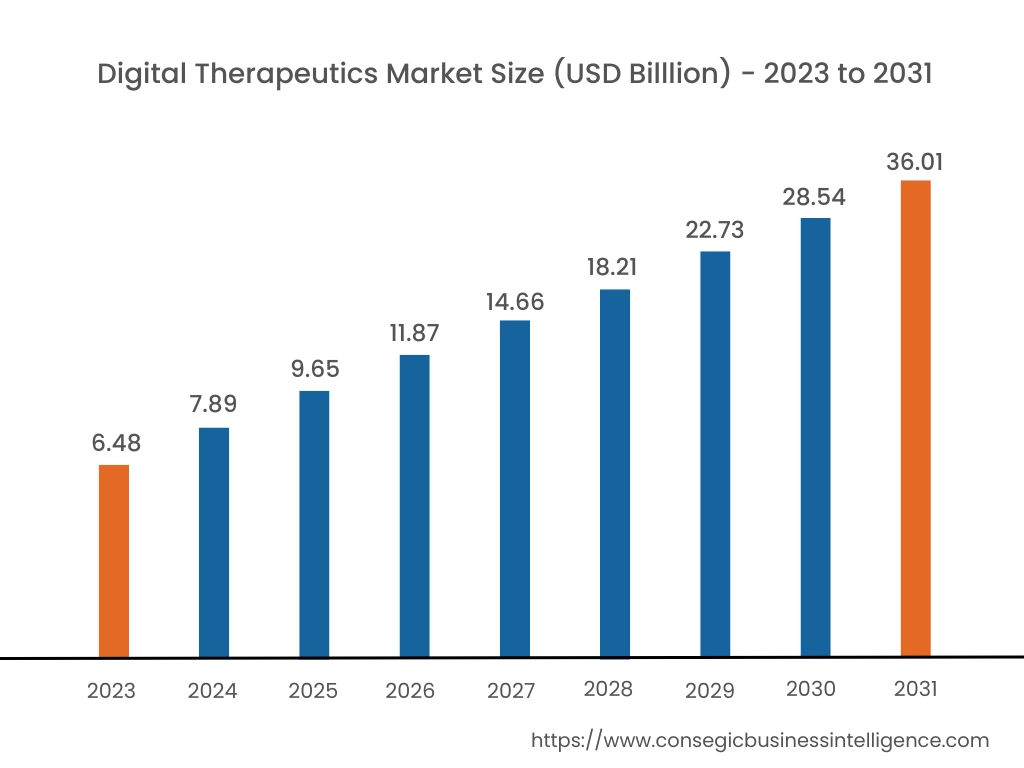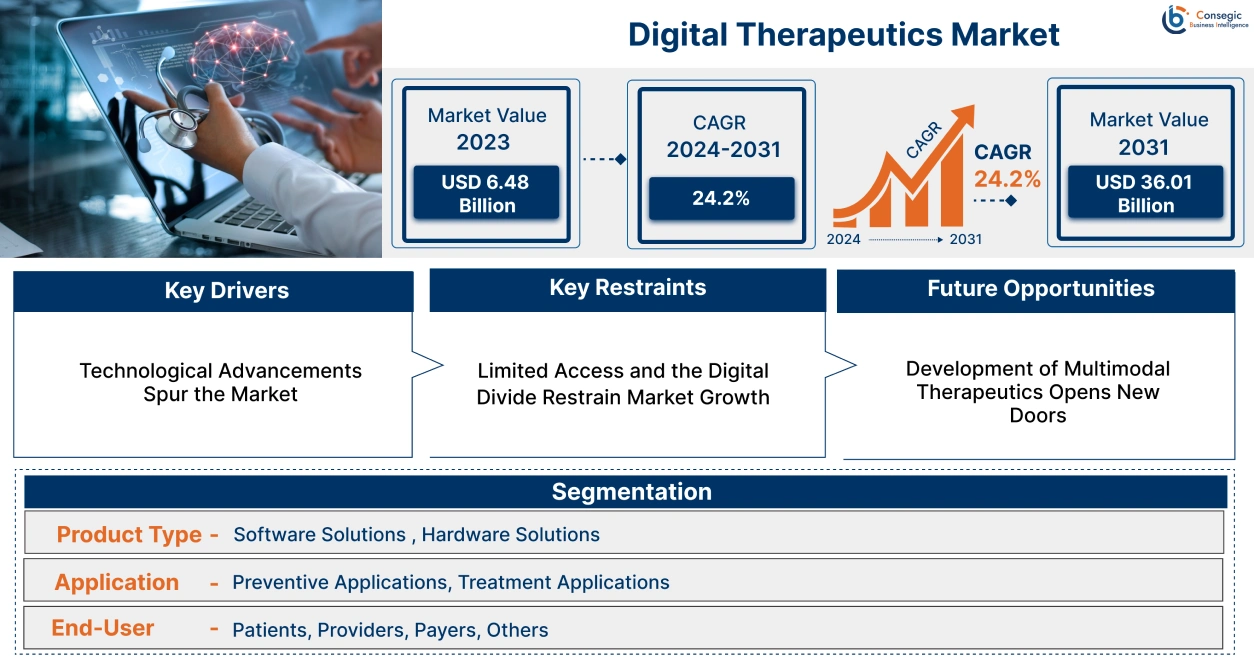- Summary
- Table Of Content
- Methodology
Digital Therapeutics Market Size and Growth 2023 to 2031:
Digital Therapeutics Market size is estimated to reach over USD 36.01 Billion by 2031 from a value of USD 6.48 Billion in 2023 and is projected to grow by USD 7.89 Billion in 2024, growing at a CAGR of 24.2% from 2024 to 2031. The North American digital therapeutics market size is valued at 2.66 Billion in 2023.
Digital Therapeutics Market Scope & Overview:
The Digital Therapeutics (DTx) develops, distributes, and uses software-based medicines to treat, manage, and avoid diseases and disorders. These evidence-based digital therapies offer therapeutic benefits and frequently improve conventional medical care. Digital platforms including wearables, smartphone apps, and web-based applications can be used to offer interventions, enabling personalized treatment regimens, real-time monitoring, and enhanced patient participation. This market includes a wide range of applications, such as mental wellness, chronic illness treatment, lifestyle management, and preventative healthcare. By fusing technology and medicine, digital medicines seek to improve patient outcomes, save costs, and raise the standard of care.
North America Digital Therapeutics Market Size and Growth 2023 to 2031:
The North America Digital Therapeutics market size was estimated at USD 2.66 billion in 2023 and is predicted to be worth around USD 14.38 billion by 2031, at a CAGR of 23.8% from 2024 to 2034.
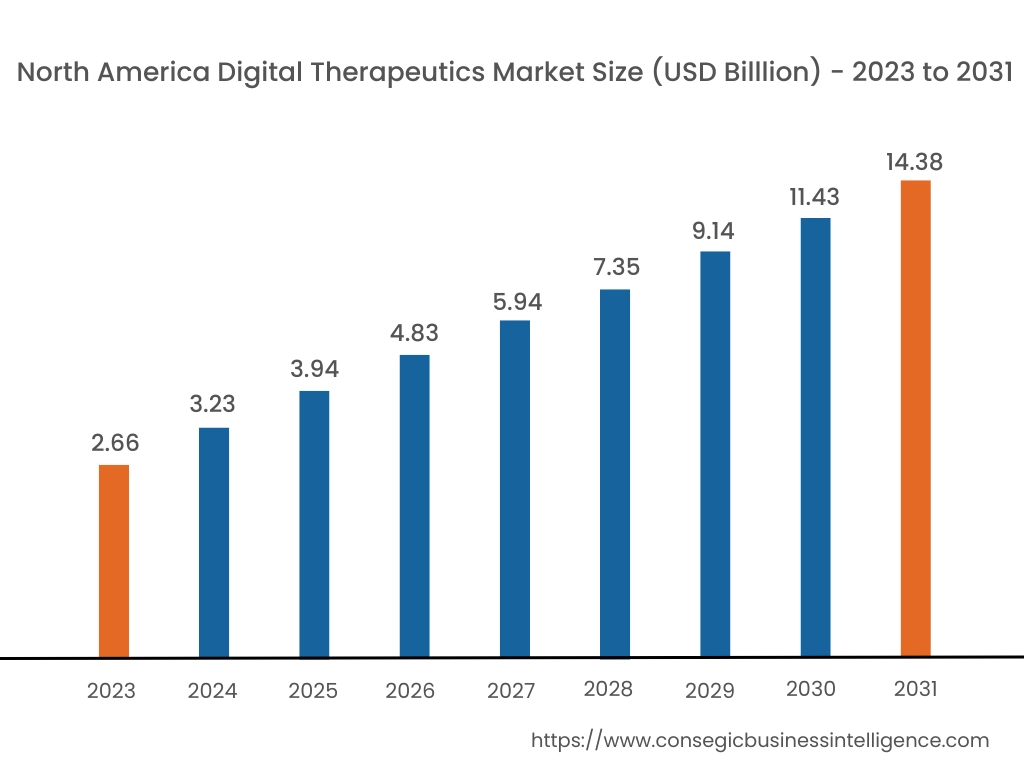
The U.S. is at the forefront due to its strong healthcare infrastructure, high prevalence of chronic diseases like diabetes and cardiovascular issues, and substantial investments in digital health technologies. The region has seen rapid adoption of digital therapeutics for patient management and disease prevention, driven by rising demand for remote healthcare solutions. Favorable reimbursement policies and regulatory support from the FDA for digital health applications contribute significantly to market development. However, data privacy concerns and cybersecurity issues remain challenges for widespread adoption.
Asia Pacific region was valued at USD 1.49 Billion in 2023. The rapid rise is driven by an increase in chronic diseases, a large aging population, and expanding digital infrastructure in countries like China, Japan, South Korea, and India. Growing awareness of digital health and mobile healthcare solutions is fueling demand, especially in diabetes and hypertension management. Government initiatives like China's Health China 2030 Plan and Japan's focus on digital healthcare transformation are creating growth opportunities. However, challenges such as unequal access to digital infrastructure and varying regulatory landscapes across countries need to be addressed.
Europe is the second-largest region in the digital therapeutics market, accounting for around 28.91% of global revenues. Countries like Germany, the UK, and France lead, driven by robust healthcare systems and increasing government initiatives promoting digital healthcare solutions. The DiGA (Digital Health Applications) law in Germany has been instrumental in integrating digital therapeutics into the healthcare system, allowing for reimbursement of certain digital health apps. The European market is experiencing a rapid rise in diabetes management, mental health solutions, and musculoskeletal conditions. Regulatory frameworks and emphasis on data protection, such as GDPR, have driven companies to prioritize security and compliance.
The Middle East and Africa region holds a smaller market share but is experiencing steady growth due to increasing investment in healthcare digitization in countries like the UAE and South Africa. The focus is on leveraging digital therapeutics to manage non-communicable diseases such as diabetes and hypertension, which have high prevalence rates in the region. Government initiatives to promote digital health and the adoption of mHealth solutions are key growth drivers. However, limited access to digital infrastructure and disparities in healthcare services between urban and rural areas remain significant challenges.
Latin America is an emerging market in digital therapeutics, led by Brazil and Mexico. The region's growth is driven by rising smartphone penetration, increasing digital health initiatives, and government efforts to improve chronic disease management. Brazil's emphasis on telehealth and digital solutions for managing diabetes and hypertension is helping drive market expansion. However, regulatory frameworks for digital health are still evolving, and economic disparities and limited healthcare budgets in certain countries present challenges for widespread adoption.
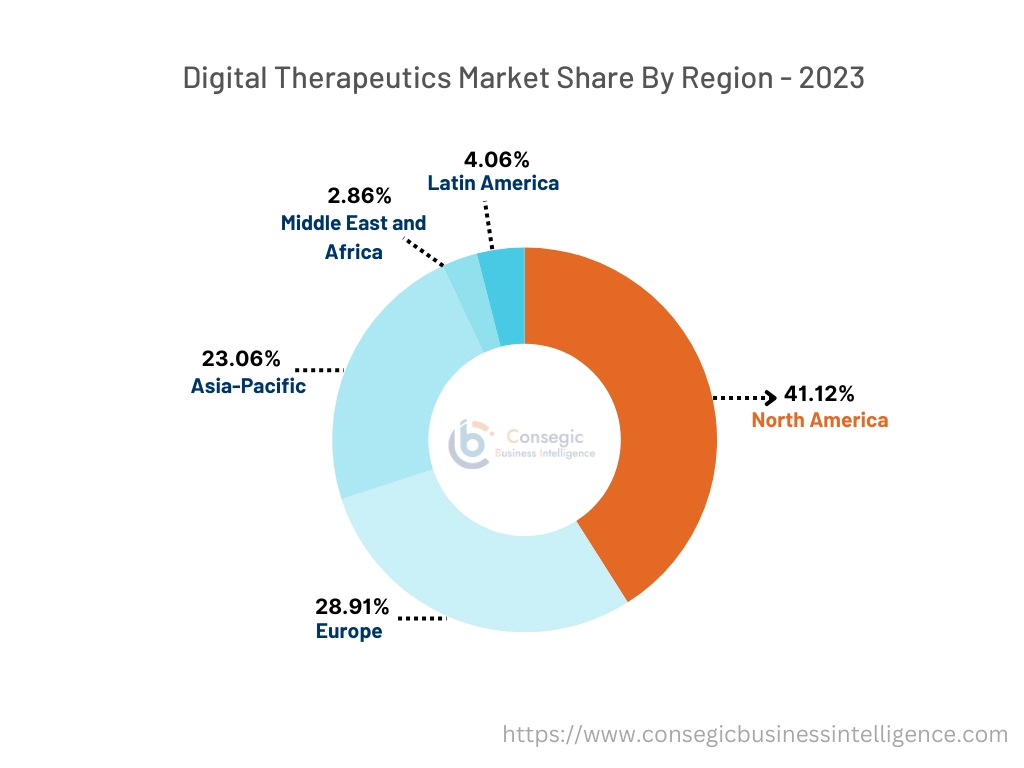
Digital Therapeutics Market Key Players:
The digital therapeutics market is highly competitive with major players providing products to the national and international markets. Key players are adopting several strategies in research and development (R&D), product innovation, and end-user launches to hold a strong position in the global digital therapeutics market. Key players in the digital therapeutics industry include-
- Omada Health(USA)
- WellDoc, Inc. (USA)
- Akili Interactive (USA)
- Kaia Health (Germany)
- Big Health (USA)
- Zywie, Inc. (USA)
- Huma (UK)
- Medisafe (USA)
- Click Therapeutics (USA)
- SilverCloud Health (Ireland)
- Cognoa (USA)
- Luminopia (USA)
Digital Therapeutics Market Trends:
The digital therapeutics market is witnessing significant growth driven by the increasing demand for personalized solutions in chronic disease management. With the integration of advanced data analytics and AI, digital therapeutics platforms can now offer tailored treatment plans based on individual patient profiles. This personalized approach enhances patient adherence and improves health outcomes, particularly in managing conditions like diabetes, cardiovascular diseases, and mental health disorders. As the healthcare sector shifts towards more patient-centric care models, the demand for these customized solutions continues to rise.
Another key trend is the integration of digital therapeutics with remote monitoring devices such as wearable sensors and smart health monitors. This development enables real-time patient data collection, providing continuous feedback to both patients and healthcare providers. The seamless combination of remote monitoring and digital therapeutics is transforming patient engagement in self-care, allowing for more proactive management of chronic diseases and preventive care measures. This trend is rapidly gaining traction as technology advancements make remote monitoring more accessible and effective.
The adoption of digital therapeutics is also expanding in the field of behavioral health, where innovative platforms are being developed to address mental health issues like depression, anxiety, and addiction. By leveraging cognitive behavioral therapy (CBT) techniques and interactive programs, these platforms are offering scalable mental health interventions, meeting the growing global demand for accessible mental healthcare solutions.
However, despite these advancements, the market faces challenges in obtaining regulatory approval and securing reimbursement. The evolving nature of digital therapeutics often requires new guidelines and clinical standards, which can delay market entry. Moreover, demonstrating cost-effectiveness and clinical efficacy to insurers remains a key hurdle, as payers demand substantial evidence before committing to reimbursements. Addressing these challenges is essential to sustaining growth and encouraging widespread adoption of digital therapeutics.
Digital Therapeutics Market Dynamics - (DRO) :
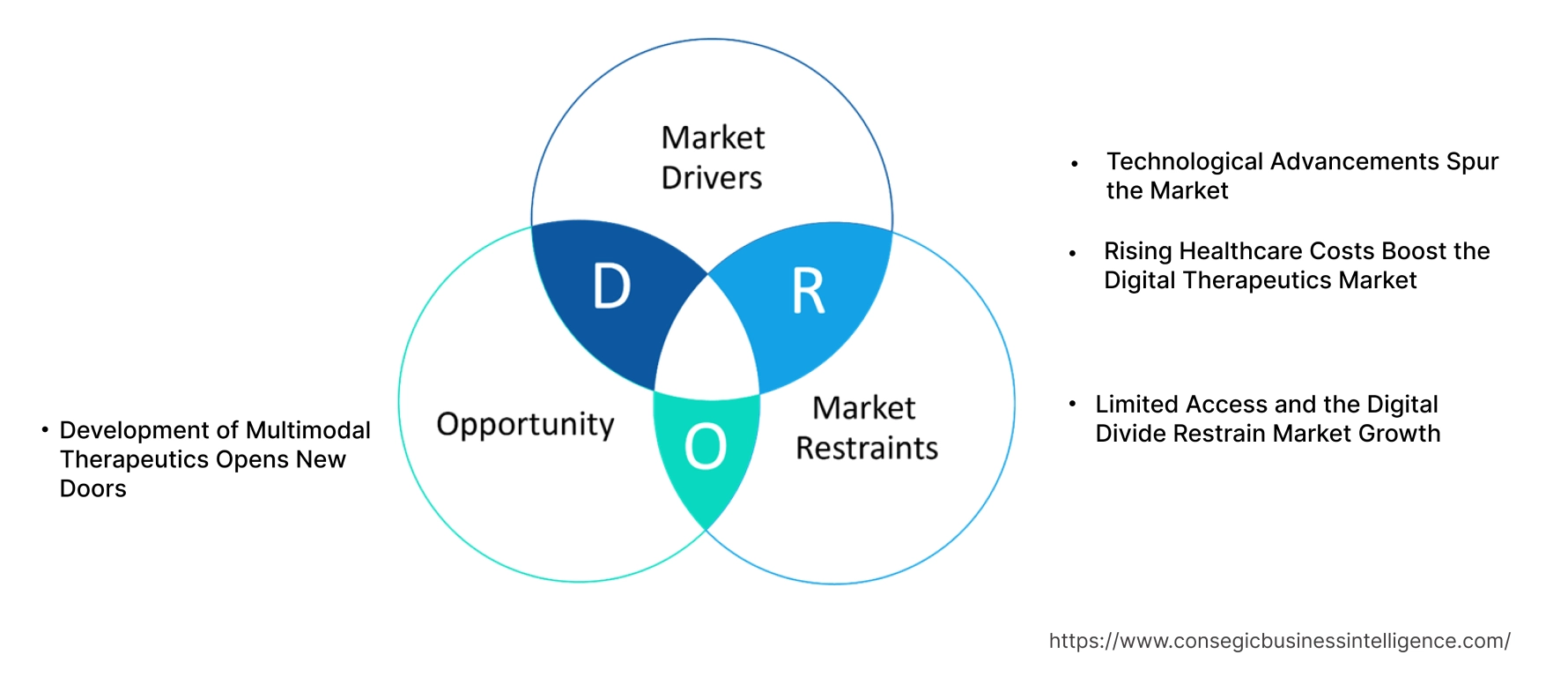
Key Drivers:
Technological Advancements Spur the Market
Technological advancements in software-driven healthcare solutions are significantly driving the digital therapeutics market. The integration of artificial intelligence (AI), machine learning, and real-time data analytics has enhanced the development of personalized treatment plans for chronic diseases. These technologies allow digital therapeutics to offer effective, tailored interventions that help manage conditions like diabetes, hypertension, and mental health disorders through remote monitoring and app-based solutions.
- For instance, the Apple Watch Series 7's FDA-approved electrocardiogram (ECG) app can identify irregular heart rhythms and alert users to conditions like atrial fibrillation. Similarly, advances in sensor technology have allowed for the development of smart patches, which can be used to monitor heart rate variability and deliver medication using less invasive procedures.
These advancements highlight how technology is transforming the wearable medical device market by providing more sophisticated, flexible, and user-friendly health monitoring alternatives.
Key Restraints :
Limited Access and the Digital Divide Restrain Market Growth
The term "digital divide" describes the discrepancy in opportunities and services that result from the presence of this technology in modern societies and the absence of it in persons and individuals. It keeps some populations from having access to digital therapies, drastically limiting the market for wearable medical devices. Inequality in internet and technology access is often the cause of this disparity, which may restrict wearable health solutions' usefulness and effectiveness.
- For instance, the National Library of Medicine highlighted in a paper from 2023 that the global digital divide has an impact on health equity globally. People living in rural and low-income nations have challenges related to poor infrastructure, which restricts their access to digital health solutions. This access gap limits the worldwide reach of wearable medical devices and exacerbates health inequities.
This demonstrates how the lack of access to modern health technologies can restrict the market for wearable medical devices from growing, particularly for those who are impoverished and neglected.
Future Opportunities :
Development of Multimodal Therapeutics Opens New Doors
Multimodal treatments refer to treatment options that mix numerous modalities, such as digital interventions, medication, and behavioral therapies, addressing different parts of a disease. The goal is to deliver comprehensive care and improve treatment efficacy. Healthcare providers can provide more complete and efficient care solutions by combining digital therapeutics with existing treatment modalities. Through the simultaneous treatment of several facets of a problem, this method can improve patient adherence and overall health outcomes. In addition to meeting a wider range of medical demands, the integration of digital tools and traditional remedies can create new market niches and increase potential uses.
- For instance, BlueStar by WellDoc is a mobile app that aids adults with type 2 diabetes by offering personalized coaching and support for medication adherence, blood glucose monitoring, and lifestyle management. This combination of digital tools with pharmacotherapy enhances patient care by integrating digital and traditional therapeutic methods.
The move into these sectors is consistent with the expanding need for accessible healthcare options and the ongoing expansion of the healthcare system.
Digital Therapeutics Market Segmentation Review:
Product Type Analysis:
Based on the product type, the market is bifurcated into Software Solutions (Mobile Applications, Web-based Applications, and Cloud-based Solutions) and Hardware Solutions (Wearable Devices and Monitoring Devices).
Trends in the Product Type:
- Web-based applications are widely used for managing chronic conditions like diabetes, hypertension, and cardiovascular diseases. These platforms provide patients and healthcare providers with access to real-time data, enabling continuous monitoring and timely interventions.
- Mobile apps in digital therapeutics are increasingly offering personalized solutions, leveraging data analytics and AI to create tailored treatment plans. This includes chronic disease management, mental health therapy, and lifestyle modification programs.
The software solutions segment accounted for the largest revenue of 72.24% in 2023 of the overall digital therapeutics market share.
- The software solutions segment encompasses applications and platforms that deliver evidence-based therapeutic interventions directly to patients via digital devices such as smartphones and tablets.
- These solutions are designed to treat, manage, and prevent a range of medical conditions by providing personalized and scalable treatment options, often enhancing traditional therapies.
- This dominance is driven by the extensive use of digital software solutions in managing chronic diseases, enhancing medication adherence, and providing personalized care.
- These software solutions, including mobile apps and web-based platforms, are instrumental in delivering behavioral interventions and self-management programs, which are critical for chronic conditions like diabetes, cardiovascular diseases, and mental health disorders.
- For instance, Noom, Inc. introduced Noom Med, a program designed to tackle obesity by combining telehealth services with personalized psychological tools. This program has significantly contributed to the company's revenue, highlighting the growing importance and success of software-based solutions.
- Thus, the market analysis depicts that the software segment is driving the digital therapeutics market trends.
The hardware segment is anticipated to register the fastest CAGR during the forecast period.
- The hardware segment includes devices such as wearable sensors, virtual reality headsets, and other connected medical devices that deliver therapeutic interventions.
- These tools collect real-time health data, provide interactive treatment experiences, and support the implementation of digital therapeutic programs, enhancing patient engagement and treatment efficacy.
- This growth is driven by advancements in wearable devices and monitoring technologies, which offer significant potential for personalized healthcare management and real-time patient data monitoring.
- The increasing adoption of these devices is being propelled by factors such as the rising prevalence of chronic diseases and the growing trend for cost-effective, patient-centered healthcare solutions.
- For instance, in 2023, Fitbit (owned by Google) introduced new wearable devices designed to assist in the management of chronic conditions like diabetes and blood pressure. These devices offer continuous health monitoring, which enhances patient compliance and provides real-time data to healthcare providers, leading to better patient outcomes and faster adoption of digital therapeutic solutions.
- Therefore, the hardware segment is anticipated to boost the digital therapeutics market opportunities during the forecast period.
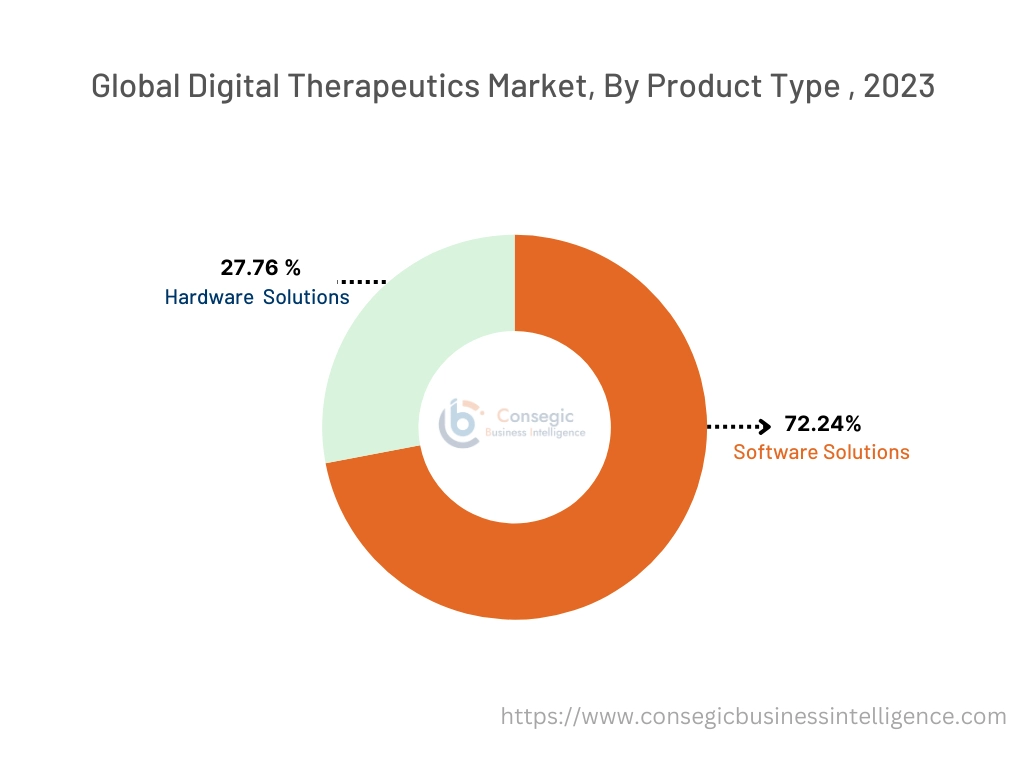
Application Analysis:
Based on application, the market is segmented into Preventive Applications (Nutrition, Obesity, Prediabetes, and Others) and Treatment Applications (Cardiovascular, Hypertension, Diabetes, Obesity, Insomnia, Mental & Behavioral Health, and Others).
Trends in the Application:
- There has been an increasing use of digital tools for personalized nutrition guidance. Apps and platforms are integrating with wearables to track dietary habits and provide real-time recommendations.
- Emphasis on comprehensive weight management programs that integrate behavioral therapy, physical activity, and dietary recommendations.
The treatment segment accounted for the largest revenue share in 2023 of the global digital therapeutics market share.
- Treatment applications refer to the use of digital tools and programs to manage and treat various medical conditions, such as chronic diseases, mental health disorders, and sleep issues, by providing interventions, monitoring, and personalized care.
- The treatment applications segment focuses on software applications designed to provide therapeutic interventions for specific medical conditions.
- These applications deliver evidence-based treatments through digital platforms, addressing areas such as chronic disease management, mental health, and behavioral health by offering personalized, scalable, and accessible treatment options.
- The dominance of this segment is driven by several key factors, including the increasing prevalence of chronic diseases, advancements in digital health technologies, integration with traditional healthcare, regulatory approvals, and reimbursements.
- For instance, Pear Therapeutics in 2021, made significant strides with its product Somryst, which is specifically designed to treat chronic insomnia, marking a notable advancement in digital treatment for sleep disorders.
- Thus, the market analysis concludes that the treatment applications segment is driving the digital therapeutics market growth.
The preventive application segment is anticipated to register the fastest CAGR during the forecast period.
- The preventive application segment includes software solutions aimed at preventing the onset or progression of diseases.
- It involves using digital tools and programs to promote healthy behaviors and prevent the onset of chronic diseases by focusing on areas such as nutrition, weight management, and lifestyle changes.
- The analysis shows that the preventive segment's growth has been attributed to increasing awareness of preventive healthcare, advancements in technology, a growing demand for personalized health management solutions, integration with wearables, and more.
- For instance, in 2022, Omada Health, a digital health company, launched a comprehensive program focused on preventing chronic diseases such as diabetes and hypertension, utilizing digital tools and personalized coaching to promote healthier lifestyles.
- Therefore, the preventive applications segment is anticipated to boost the digital therapeutics market opportunities during the forecast period.
End User Analysis:
Based on the end user, the market is segmented into Patients, Providers, Payers, and others.
Trends in End-User:
- Insurance companies and other payers are recognizing the cost-saving potential of digital therapeutics and incorporating them into reimbursement models.
- Healthcare providers are increasingly integrating digital therapeutics into their practice to enhance patient care and outcomes.
The provider's segment accounted for the largest revenue share in 2023.
- The providers segment refers to healthcare providers such as hospitals, clinics, and medical practices that integrate digital therapeutic solutions into their care delivery.
- These providers use it to enhance treatment protocols, improve patient outcomes, and offer personalized, scalable interventions for various medical conditions.
- The providers segment in the digital therapeutics market refers to healthcare professionals and institutions, such as hospitals, clinics, and medical practices that integrate digital therapeutic solutions into their clinical practice to enhance patient care and improve health outcomes.
- The significant growth of the provider segment is driven by the growing adoption of digital therapeutic solutions via its integration into clinical practice, remote patient monitoring, and more.
- For instance, Kaiser Permanente, a leading healthcare provider in the United States, expanded its use of digital therapeutics for managing conditions such as diabetes, hypertension, and mental health disorders. By integrating digital therapeutic solutions with traditional care, they could offer patients continuous monitoring, real-time feedback, and personalized treatment plans. This allowed them to improve patient outcomes, reduce hospital readmissions, and lower overall healthcare costs.
- Thus, the market analysis concludes that the providers segment is driving the digital therapeutics market growth.
The patient segment is anticipated to register the fastest CAGR during the forecast period.
- The patient segment consists of individuals using digital health applications to manage, treat, or prevent medical conditions.
- These individuals use digital health solutions, such as mobile apps and wearables, to manage their health conditions, improve adherence to treatments, and enhance overall well-being.
- This growth is driven by increasing patient demand for digital health solutions, advancements in technology, increased patient awareness, personalized health management, and the shifting trend towards more personalized and accessible healthcare.
- For instance, Pursue Care's reSET-O, a prescription digital therapeutic for managing opioid use disorder, has seen significant adoption among patients since its FDA approval. This provides evidence-based treatment through a mobile app, helping patients manage their recovery and adherence to therapy.
- Therefore, the patients segment is anticipated to boost the digital therapeutics market trends during the forecast period.
Recent Industry Developments :
Product launches
- In April 2024, Akili Interactive released an updated version of EndeavorRx, called EndeavorRx v2 enhancing its features for ADHD management with improved game-based cognitive training.
- In February 2024, Kaia Health introduced an upgraded version of its digital therapeutic called Kaia COPD 2.0 for chronic obstructive pulmonary disease (COPD), incorporating new AI-driven features for personalized care.
Mergers & Acquisitions
- In June 2024, Teladoc Health expanded its digital therapeutics capabilities by acquiring Livongo's division, enhancing its offerings for chronic disease management.
Partnerships & Collaborations
- On July 29, 2024, Boehringer Ingelheim acquired Nerio Therapeutics Inc. The company aims to develop Neiro's innovative preclinical program as a potential key centerpiece component for its immuno-oncology portfolio.
Digital Therapeutics Market Report Insights :
| Report Attributes | Report Details |
| Study Timeline | 2018-2031 |
| Market Size in 2031 | USD 36.01 Billion |
| CAGR (2024-2031) | 24.2% |
| By Product Type |
|
| By Application |
|
| By End User |
|
| By Region |
|
| Key Players |
|
| North America | U.S. Canada Mexico |
| Europe | U.K. Germany France Spain Italy Russia Benelux Rest of Europe |
| APAC | China South Korea Japan India Australia ASEAN Rest of Asia-Pacific |
| Middle East and Africa | GCC Turkey South Africa Rest of MEA |
| LATAM | Brazil Argentina Chile Rest of LATAM |
| Report Coverage |
|
Key Questions Answered in the Report
How big is the digital therapeutics market? +
Digital Therapeutics Market size is estimated to reach over USD 36.01 Billion by 2031 from a value of USD 6.48 Billion in 2023 and is projected to grow by USD 7.89 Billion in 2024, growing at a CAGR of 24.2% from 2024 to 2031.
Which is the fastest-growing region in the digital therapeutics market? +
Asia-Pacific is the region experiencing the most rapid growth in the digital therapeutics market.
What specific segmentation details are covered in the digital therapeutics report? +
The digital therapeutics report includes specific segmentation details for product type, application, end-user, and region.
Who are the major players in the digital therapeutics market? +
The key players in the digital therapeutics market are Omada Health (USA), WellDoc, Inc. (USA), Huma (UK), Akili Interactive (USA), Kaia Health (Germany), Big Health (USA), Zywie, Inc. (USA), Medisafe (USA), Click Therapeutics (USA), SilverCloud Health (Ireland), Cognoa (USA), and Luminopia (USA).
